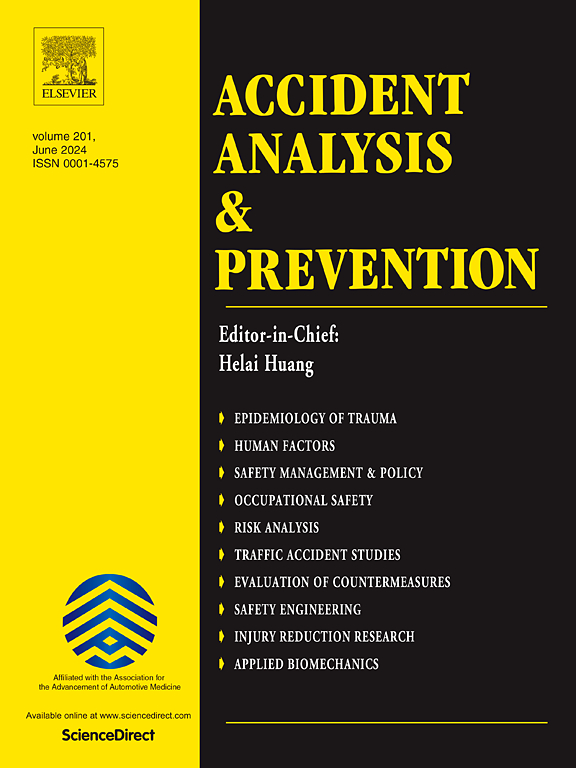An interpretable stacking ensemble learning model for visual-manual distraction level classification for in-vehicle interactions
IF 6.2
1区 工程技术
Q1 ERGONOMICS
引用次数: 0
Abstract
Recognizing the level of driver distraction during the execution of secondary tasks within the intelligent cockpit is crucial for ensuring a seamless interaction between human drivers and intelligent vehicle systems. To address this issue, this paper proposes a framework for recognizing driver distraction levels that integrates clustering, classification, and interpretability. First, Feature Selection with Optimal Graph(SF2SOG) is employed to identify discriminative features from the data facilitating dimensionality reduction. Following this, Agglomerative Clustering are employed to classify the gathered unlabeled data on driving distraction behaviors into three distinct categories. Additionally, a heuristic-based stacking ensemble model is introduced to identify the levels of driver distraction, using the factors that influence these levels as input parameters for classification. To improve the effectiveness of the stacking model, three diverse classifiers adaptive boosting (AdaBoost)、random forest (RF) and extreme gradient boosting (XGBoost) are selected to serve as the base models, while a relatively simple yet accurate model logistic regression (LR) is used as the meta-classifier. Finally, Shapley Additive exPlanations (SHAP) is employed for interpretability analysis. Notably, heuristic-based stacking ensemble model achieved a commendable accuracy rate of 96.25%, highlighting its significant advantage. Further analysis shows that higher maximum pupil diameter (maxPD) and mean pupil diameter (meanPD) indicate increased distraction, while greater glance frequency and lane deviation reflect reduced situational awareness and control. These findings are crucial for reducing accidents and enhancing driving safety in the era of intelligent vehicles.
一种可解释的叠加集成学习模型,用于车内交互的视觉-手动分心水平分类
在智能驾驶舱内执行次要任务时,识别驾驶员的分心程度对于确保驾驶员与智能车辆系统之间的无缝交互至关重要。为了解决这个问题,本文提出了一个识别驾驶员分心程度的框架,该框架集成了聚类、分类和可解释性。首先,采用最优图特征选择(SF2SOG)从数据中识别判别特征,便于降维;在此基础上,采用聚类方法将收集到的未标记驾驶分心行为数据分为三种不同的类别。此外,引入了一种基于启发式的叠加集成模型来识别驾驶员分心的水平,使用影响这些水平的因素作为分类的输入参数。为了提高叠加模型的有效性,选择自适应增强(AdaBoost)、随机森林(RF)和极端梯度增强(XGBoost)三种不同的分类器作为基础模型,而使用相对简单但准确的模型逻辑回归(LR)作为元分类器。最后,采用Shapley加性解释(SHAP)进行可解释性分析。值得注意的是,启发式叠加集成模型的准确率达到了96.25%,突出了其显著的优势。进一步分析表明,较大的最大瞳孔直径(maxPD)和平均瞳孔直径(meanPD)表明注意力分散程度增加,而较大的注视频率和车道偏离则表明态势感知和控制能力下降。这些发现对于在智能汽车时代减少事故和提高驾驶安全性至关重要。
本文章由计算机程序翻译,如有差异,请以英文原文为准。
求助全文
约1分钟内获得全文
求助全文
来源期刊

Accident; analysis and prevention
Multiple-
CiteScore
11.90
自引率
16.90%
发文量
264
审稿时长
48 days
期刊介绍:
Accident Analysis & Prevention provides wide coverage of the general areas relating to accidental injury and damage, including the pre-injury and immediate post-injury phases. Published papers deal with medical, legal, economic, educational, behavioral, theoretical or empirical aspects of transportation accidents, as well as with accidents at other sites. Selected topics within the scope of the Journal may include: studies of human, environmental and vehicular factors influencing the occurrence, type and severity of accidents and injury; the design, implementation and evaluation of countermeasures; biomechanics of impact and human tolerance limits to injury; modelling and statistical analysis of accident data; policy, planning and decision-making in safety.
 求助内容:
求助内容: 应助结果提醒方式:
应助结果提醒方式:


